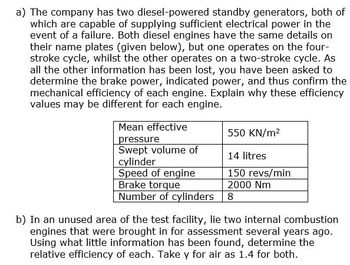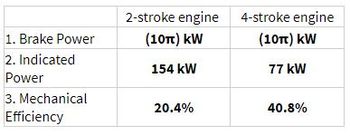
Elements Of Electromagnetics
7th Edition
ISBN: 9780190698614
Author: Sadiku, Matthew N. O.
Publisher: Oxford University Press
expand_more
expand_more
format_list_bulleted
Question
thumb_up100%
Hello, so i have attached two images. the first image is the quetions, i need part b) answered if possible. i have attached my findings to part a) to add to the little information we know to help with part b if needed. Thnks

Transcribed Image Text:a) The company has two diesel-powered standby generators, both of
which are capable of supplying sufficient electrical power in the
event of a failure. Both diesel engines have the same details on
their name plates (given below), but one operates on the four-
stroke cycle, whilst the other operates on a two-stroke cycle. As
all the other information has been lost, you have been asked to
determine the brake power, indicated power, and thus confirm the
mechanical efficiency of each engine. Explain why these efficiency
values may be different for each engine.
Mean effective
550 KN/m²
pressure
Swept volume of
14 litres
cylinder
Speed of engine
150 revs/min
Brake torque
2000 Nm
Number of cylinders | 8
b) In an unused area of the test facility, lie two internal combustion
engines that were brought in for assessment several years ago.
Using what little information has been found, determine the
relative efficiency of each. Take y for air as 1.4 for both.

Transcribed Image Text:1. Brake Power
2. Indicated
Power
3. Mechanical
Efficiency
2-stroke engine
(10π) KW
154 kW
20.4%
4-stroke engine
(10) KW
77 kW
40.8%
Expert Solution
This question has been solved!
Explore an expertly crafted, step-by-step solution for a thorough understanding of key concepts.
Step by stepSolved in 3 steps with 2 images

Follow-up Questions
Read through expert solutions to related follow-up questions below.
Follow-up Question
The p-v diagram all make sense, but the equations are unreadable. i dont understand where some units have come from etc, could you please further explain the equations. thnks, feel free to take the relevant amount of credits
Solution
by Bartleby Expert
Follow-up Questions
Read through expert solutions to related follow-up questions below.
Follow-up Question
The p-v diagram all make sense, but the equations are unreadable. i dont understand where some units have come from etc, could you please further explain the equations. thnks, feel free to take the relevant amount of credits
Solution
by Bartleby Expert
Knowledge Booster
Learn more about
Need a deep-dive on the concept behind this application? Look no further. Learn more about this topic, mechanical-engineering and related others by exploring similar questions and additional content below.Similar questions
- I want you to draw HGL& EGL For the first picture using the same method on the second picturearrow_forwardPlz solve it within half n hour and plz hand written..... I'll give you multiple upvote hand written plz..... Plz solve 1 hour...arrow_forwardPlease solve the question on the sheet and get a clear picture and submit the picture. thankyouarrow_forward
- I need answers to questions 1, 2, and 3 pertaining to the print provided. Note: A tutor keeps putting 1 question into 3 parts and wasted so many of my questions. Never had a issue before until now, please allow a different tutor to answer because I was told I am allowed 3 of these questions.arrow_forwardI could not figure this problem during lecture please help me solve it! ANSWER ALL OR DO NOT ATTEMPTarrow_forwardPlease make the exact graph that you see in the picture, along with the graph are numbers that are data. Please make the exact graph do not make anything thing different, the blue and orange circles should be there and the lines should be the same including the titles. Please make sure everything is exactly the same. Use MATLAB, and send the code and please make sure no error signs comes up. Take your time please I need help.arrow_forward
- I need answers to these 3 parts for a review activity.arrow_forwardI asked for problems 6 and 7 to be answered, but I did not get a properly structured answered as the example shows on problem number 1. Here is the link to the questions I already had answered, could you please rewrite the answer so its properly answered as the example shows (Problem 1)? https://www.bartleby.com/questions-and-answers/it-vivch-print-reading-for-industry-228-class-date-name-review-activity-112-for-each-local-note-or-c/cadc3f7b-2c2f-4471-842b-5a84bf505857arrow_forwardmechanical engineering : engineering drawing : AutoCAD Can someone please show step by step solution how to draw this in autocad 2D sketch ? With snapshotsarrow_forward
- Which of the following is not a good match? A )The burning material: Wood, The firefighting material:ABC powder B )The burning material: Plastic, The firefighting material: Water C )The burning material: Magnesium, The firefighting material: Sand D )The burning material: Cooking oil, The firefighting material: Wet chemical E )The burning material: Electrical contact, The firefighting material:Foam sprayarrow_forwardI am attaching both questions for 4 and 5 with the question in the image. thank you. NOTE : So the last person answered this question WITHOUT refencing the answer for whether question 4 or 5 answeres were given, so i am asking for question 5(or the answer for the question that was NOT solved because it was not referenced.) These were the following answers given to me from the last person on bartleby who answered my question without referencing whether it was the answer for question 4 or 5. 1 pass 2 fail 3 fail 4 passarrow_forwardI need these three parts answered, if you are unable to answer all three parts please leave it for another tutor to answer, thank you.arrow_forward
arrow_back_ios
SEE MORE QUESTIONS
arrow_forward_ios
Recommended textbooks for you
 Elements Of ElectromagneticsMechanical EngineeringISBN:9780190698614Author:Sadiku, Matthew N. O.Publisher:Oxford University Press
Elements Of ElectromagneticsMechanical EngineeringISBN:9780190698614Author:Sadiku, Matthew N. O.Publisher:Oxford University Press Mechanics of Materials (10th Edition)Mechanical EngineeringISBN:9780134319650Author:Russell C. HibbelerPublisher:PEARSON
Mechanics of Materials (10th Edition)Mechanical EngineeringISBN:9780134319650Author:Russell C. HibbelerPublisher:PEARSON Thermodynamics: An Engineering ApproachMechanical EngineeringISBN:9781259822674Author:Yunus A. Cengel Dr., Michael A. BolesPublisher:McGraw-Hill Education
Thermodynamics: An Engineering ApproachMechanical EngineeringISBN:9781259822674Author:Yunus A. Cengel Dr., Michael A. BolesPublisher:McGraw-Hill Education Control Systems EngineeringMechanical EngineeringISBN:9781118170519Author:Norman S. NisePublisher:WILEY
Control Systems EngineeringMechanical EngineeringISBN:9781118170519Author:Norman S. NisePublisher:WILEY Mechanics of Materials (MindTap Course List)Mechanical EngineeringISBN:9781337093347Author:Barry J. Goodno, James M. GerePublisher:Cengage Learning
Mechanics of Materials (MindTap Course List)Mechanical EngineeringISBN:9781337093347Author:Barry J. Goodno, James M. GerePublisher:Cengage Learning Engineering Mechanics: StaticsMechanical EngineeringISBN:9781118807330Author:James L. Meriam, L. G. Kraige, J. N. BoltonPublisher:WILEY
Engineering Mechanics: StaticsMechanical EngineeringISBN:9781118807330Author:James L. Meriam, L. G. Kraige, J. N. BoltonPublisher:WILEY

Elements Of Electromagnetics
Mechanical Engineering
ISBN:9780190698614
Author:Sadiku, Matthew N. O.
Publisher:Oxford University Press

Mechanics of Materials (10th Edition)
Mechanical Engineering
ISBN:9780134319650
Author:Russell C. Hibbeler
Publisher:PEARSON

Thermodynamics: An Engineering Approach
Mechanical Engineering
ISBN:9781259822674
Author:Yunus A. Cengel Dr., Michael A. Boles
Publisher:McGraw-Hill Education

Control Systems Engineering
Mechanical Engineering
ISBN:9781118170519
Author:Norman S. Nise
Publisher:WILEY

Mechanics of Materials (MindTap Course List)
Mechanical Engineering
ISBN:9781337093347
Author:Barry J. Goodno, James M. Gere
Publisher:Cengage Learning

Engineering Mechanics: Statics
Mechanical Engineering
ISBN:9781118807330
Author:James L. Meriam, L. G. Kraige, J. N. Bolton
Publisher:WILEY